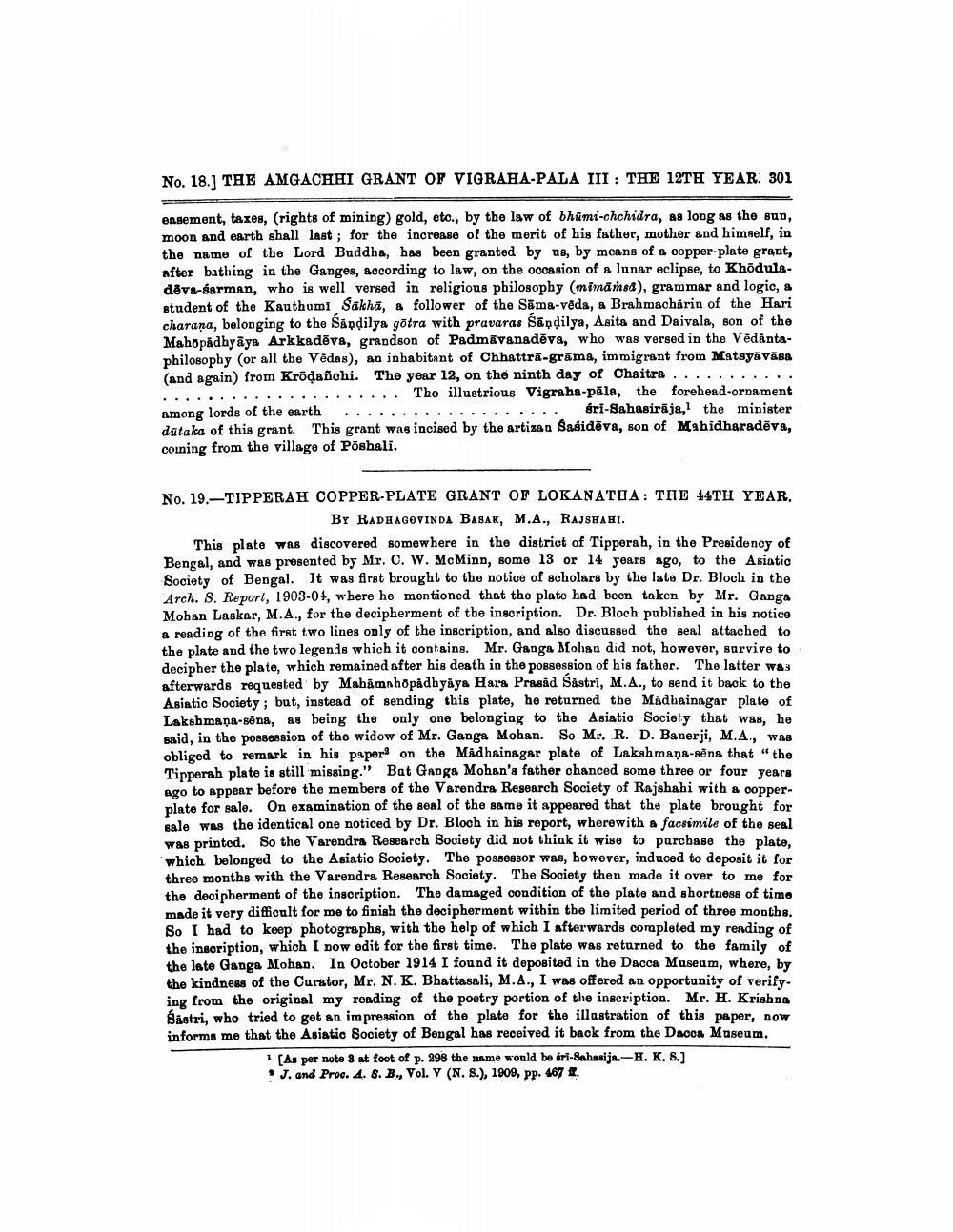________________
No. 18.1 THE AMGACHHI GRANT OF VIGRAHA-PALA III : THE 12TH YEAR. 301
eagement, taxes, (rights of mining) gold, etc., by the law of bhūmi-chchidra, as long as the sun, moon and earth shall last ; for the increase of the merit of his father, mother and himself, in the name of the Lord Buddha, has been granted by us, by means of a copper-plate grant, after bathing in the Ganges, according to law, on the occasion of a lunar eclipse, to Khoduledēva-garman, who is well versed in religious philosophy (mināmsd), grammar and logic, a student of the Kauthumi Sakha, a follower of the Sāma-veda, a Brahmacharin of the Hari charana, belonging to the Sandilya götra with pravaras Sandilya, Asita and Daivala, son of the Mahopadhyāya Arkkadēva, grandson of Padmāvanadēva, who was versed in the Vēdäntaphilosophy (or all the Vēdas), an inhabitant of Chhattrā-grāma, immigrant from Matsyāvāsa (and again) from Krõdañchi. The year 12, on the ninth day of Chaitra ........... ..................... The illustrious Vigraha-pāla, the forehead-ornament among lords of the earth ................... fri-Sahasirāja, the minister dataka of this grant. This grant was incised by the artizan Sasidēva, son of Mahidharadēva, coining from the village of Poshali.
No. 19.-TIPPERAH COPPER-PLATE GRANT OF LOKANATHA: THE 14TH YEAR.
BY RADHAGOVINDA Basar, M.A., RAJSHAHI. This plate was discovered somewhere in the district of Tipperah, in the Presidency of Bengal, and was presented by Mr. O. W. McMinn, some 13 or 14 years ago, to the Asiatic Society of Bengal. It was first brought to the notice of scholars by the late Dr. Bloch in the Arch. 8. Report, 1903-01, where he mentioned that the plate had been taken by Mr. Ganga Mohan Laskar, M.A., for the decipherment of the inscription. Dr. Bloch published in his notice a reading of the first two lines only of the inscription, and also discussed the seal attached to the plate and the two legends which it contains. Mr. Ganga Mohan did not, however, survive to decipher the plate, which remained after his death in the possession of his father. The latter was afterwards requested by Mahamahopadhyaya Hara Prasåd Såstri, M.A., to send it back to the Asiatic Society; but, instead of sending this plate, he returned the Madhainagar plate of Lakshmana-sēna, as being the only one belonging to the Asiatic Society that was, he said, in the possession of the widow of Mr. Ganga Mohan. So Mr. R. D. Banerji, M.A., was obliged to remark in his paper on the Mädhainagar plate of Lakshmana-sëna that the Tipperah plate is still missing." Bat Ganga Mohan's father chanced some three or four years ago to appear before the members of the Varendra Research Society of Rajshahi with a copperplate for sale. On examination of the seal of the same it appeared that the plate brought for sale was the identical one noticed by Dr. Bloch in his report, wherewith a facsimile of the seal was printod. So the Varendra Research Society did not think it wise to purchase the plate, which belonged to the Asiatio Society. The possessor was, however, induced to deposit it for three months with the Varendra Research Society. The Society then made it over to me for the decipherment of the inscription. The damaged condition of the plate and shortness of time made it very difficult for me to finish the decipherment within the limited period of three months. So I had to keep photographs, with the help of which I afterwards completed my reading of the inscription, which I now edit for the first time. The plate was returned to the family of the late Ganga Mohan. In October 1914 I found it deposited in the Dacca Museum, where, by the kindness of the Curator, Mr. N. K. Bhattasali, M.A., I was offered an opportunity of verify. ing from the original my reading of the poetry portion of the inscription. Mr. H. Krishna Šāstri, who tried to get an impression of the plate for the illastration of this paper, now informs me that the Asiatic Society of Bengal has received it back from the Dacoa Museum.
As per note 8 at foot of p. 298 the name would be iri-Sahasija.-H. K. 8.] • J. and Proc. 4. 8. B., Vol. Y (N. S.), 1909, pp. 467 4.




